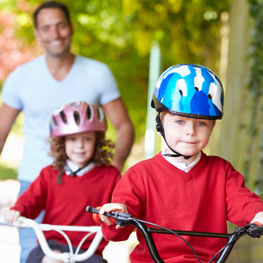
In many schools, fewer hours are allotted to recess and physical education each year, but summer is the perfect time to commit to the challenge of your kids riding to day camp or getting them physically prepared now to ride their bikes to school in the Fall.Bicycling is a fun and fitness-friendly method of transportation that, with a little planning and attention to details, could replace your carpool.
Child development research by Safe Kids Worldwide indicates that children under the age of 10 have difficulty judging the speed and distance of traffic. Coordination and strong bike-handling skills are not a substitute for the quick decision-making ability needed to ride on the road, so very young cyclists should always be accompanied by an adult. Before allowing children to ride alone, assess their skills and judgment. Teach them to make eye contact with drivers, particularly before crossing intersections. This increases the likelihood that traffic will be stopped before they cross the street.
Before your child’s first solo trek, discuss the terrain and type of traffic they might encounter. Even if you have ridden the route together in the past, take a ride to point out details and identify any potential hazards. A child who has always followed an adult has not had to rely on their own judgment and may not be confident of the route.
Require children to wear a properly-fitting bike helmet every time they ride. Adults should do the same for safety and to serve as a role model. New helmets come with an adjuster ring or sizing pads. Use these to keep the helmet snug so it does not shift in any direction. Position the helmet low on the forehead, the width of one or two fingers above the eyebrows. Straps should not rub on the ears. To check whether the chin strap is tight enough, have your child open their mouth wide like a yawn. If the strap is tight enough, yawning will tug the helmet down onto the head. When in doubt, visit your local bicycle shop for a fitting. Helmet use is the single most effective way to reduce bicycle-related fatalities.
Provide your child with a bicycle that fits. A bike to ‘grow into’ is difficult to control, will cause your child to swerve and will reduce their ability to respond quickly to changing conditions. When standing over a bike with both feet flat on the ground, there should be two or more inches of clearance above the top tube. When seated, the rider should not have to stretch or lean forward dramatically to reach the handlebars. Leaning too heavily will restrict the ability to steer.
Maintain your child’s bike. If you are not sure how to do this, enroll in a bike maintenance class as a family so everyone develops these skills. Regularly check reflectors, brakes, chains and tires to assure that they are in good working order. Check the fit of your child’s helmet periodically as well. Tighten straps that become loose and replace a helmet that has been outgrown or suffered damage.
Dress appropriately. Avoid long or loose clothing that can drag or get caught while riding. Wear bright colors, such as an orange or yellow vest, to be more visible to drivers. While messenger bags might be cool, they can slip, flop around and pull your child off balance. Instead, have kids wear a backpack. Use both shoulder straps when riding and fasten the hip belt to keep the load, and the bike, from shifting unexpectedly.
Obey traffic laws. According to the National Highway Traffic Safety Administration (NHTSA), bicycles on the roadway are, by law, vehicles with the same rights and responsibilities of motorized vehicles. Cyclists on the roadway, including children, should always ride with traffic, use signals and obey all traffic signs and rules.
Whether your child is begging for the responsibility of riding alone, or your whole family is ready for a two-wheeled commute, take advantage of the long summer days by getting out on your bike this season. Get fit, have fun and stay safe. What better way to ride into the summer than pedal-power?
Heather is a freelance writer and mother of three girls. She needs to buy a new bicycle; hers has been appropriated by her middle daughter who refuses to stop growing.
Calgary’s Child Magazine © 2024 Calgary’s Child